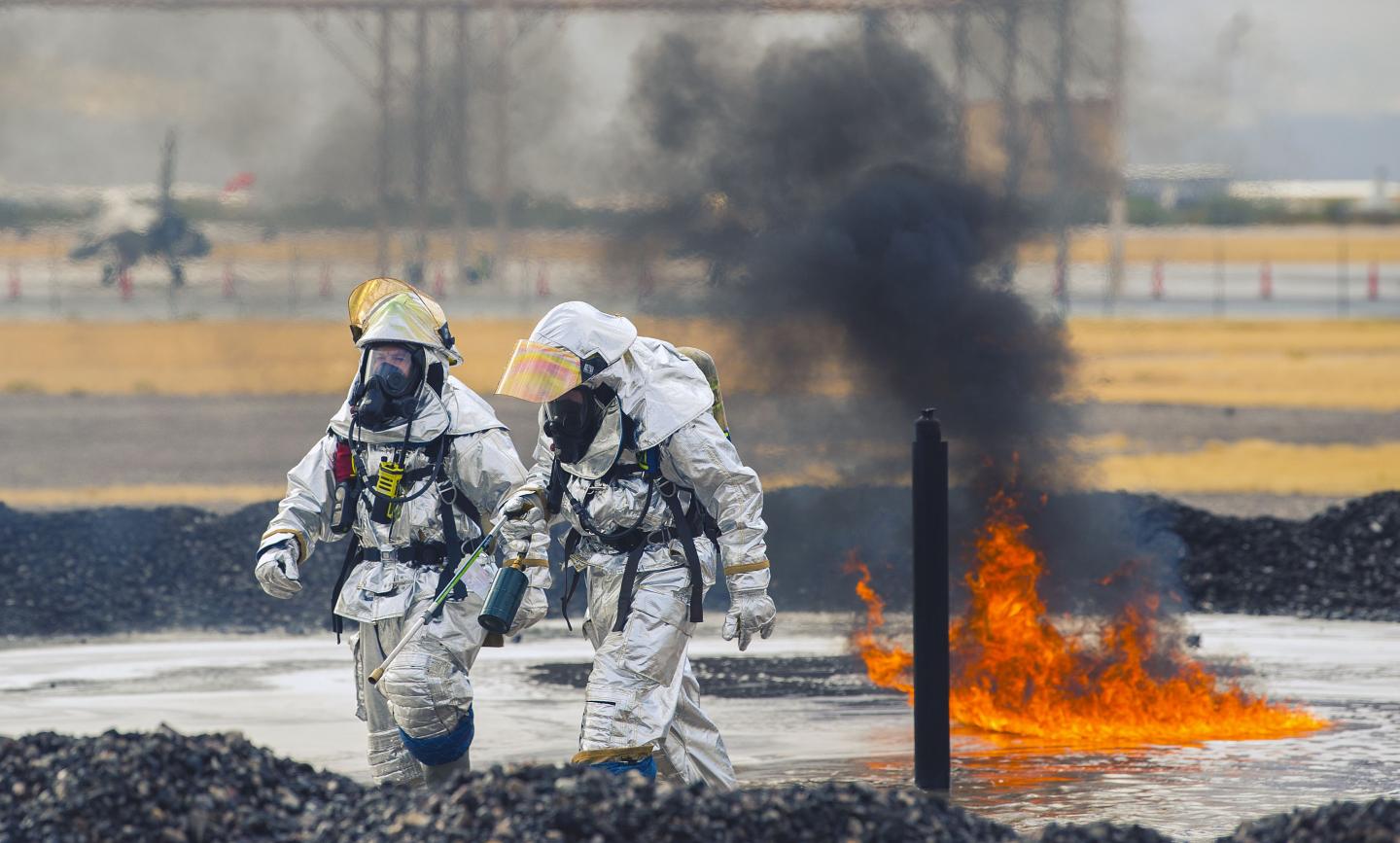A $1.2M Department of Defense grant will help UA engineers further research into removing PFAS from groundwater supplies

Credit: U.S. Air Force/Airman 1st Class Michael X. Beyer
For decades, manmade chemicals known as per- and polyfluoroalkyl substances, or PFAS, were used in everything from carpets to frying pans to firefighting chemicals for their ability to repel water and oil. That was before a wide array of negative health effects ranging from cancer and low birth weights to effects on the immune system were discovered in some kinds of PFAS.
The Environmental Protection Agency places health-based limits on the concentration of contaminants allowed in drinking water. The federal limit for arsenic in drinking water is 10 parts per billion. The federal limit for perchloroethene, a chemical associated with several types of cancer, is 5 parts per billion. The federal health advisory limit for the sum of both PFOS and PFOA – two widely used types of PFAS – is many times more stringent at 70 parts per trillion. One part per trillion is equal to one drop of water in the combined volume of 20 Olympic-size swimming pools.
“Not only are the chemicals everywhere, and bad, but the advisory level established by the EPA is so extremely low that it makes it even more challenging to treat them,” said Reyes Sierra, a chemical and environmental engineering professor who is affiliated with the UA’s Institute of the Environment. “The University of Arizona is doing something about it.”
Using a $1.2 million grant from the U.S. Department of Defense’s Strategic Environmental Research and Development Program, Reyes is leading a team in developing a new method for removing PFAS contaminants from groundwater. This research is particularly timely in light of PFAS levels of 30 parts per trillion being found in parts of Tucson’s water supply in late 2018, according to reporting by the Arizona Daily Star. Thirty parts per trillion is below the EPA advisory level, but almost double the level a June 2018 study by the federal Agency for Toxic Substances Disease Registry found advisable for drinking. These chemicals’ presence in firefighting chemicals means they often are found on military bases and in adjacent groundwater – in this case, in water wells north of Tucson’s Davis-Monthan Air Force Base.
Sierra’s co-principal investigators are: Jim Field, a professor in chemical and environmental engineering and the College of Engineering’s assistant dean for graduate education; Jon Chorover, professor and department head for Soil, Water and Environmental Sciences in the College of Agriculture and Life Sciences; Leif M. Abrell, an associate research scientist in Soil, Water and Environmental Sciences; and Jim Hatton, a senior engineer and principal technologist with Jacobs Engineering Group, a global engineering company.
Identifying ‘Super Sorbents’
One of the most widely applied methods for treating hazardous contaminants in groundwater is granular activated carbon, or GAC, adsorption. In GAC adsorption, combusted organic materials similar to coal attract groundwater contaminants through sorption, a chemical process in which one substance – the contaminant – becomes attached to another – the sorbent.
If you’ve ever looked inside the filter for the kind of water pitcher you keep in a refrigerator, you might have seen a fine substance that looks like black sand. That’s GAC; however, GAC’s affinity for PFAS isn’t especially high, so scientists have to use a lot of it to remove a sufficient amount of PFAS from water, making it an expensive option.
Sierra’s team plans to use a new class of sorbents that will attract PFAS more strongly than GAC. These sorbents also will be more customizable in their ability to bond to specific kinds of PFAS. In the early phases of the project, the research team is working with simulated groundwater they make themselves, and which includes other contaminants besides PFAS, to make sure the presence of more than one contaminant doesn’t interfere with their method.
“As we move forward, we’re going to bring contaminated water in from two military bases,” Sierra said. “Once we select the sorbents that work the best, then we’ll move on to test them in the very realistic conditions, in which we’ll use actual groundwater.”
Planning Ahead for Purification
This new treatment method is first being developed for a common type of groundwater treatment in which water is purified by pumping it through the sorbents. But it also will have potential applications to a form of treatment in which sorbents are added directly to the groundwater source.
Sierra and her team also are testing their sorbents’ effectiveness in treating several other potentially hazardous PFAS chemicals that are receiving increasing attention from regulatory agencies and which may be monitored by the EPA in the future. They hope their forward thinking will improve water safety for both Tucsonans and people throughout the world well into the future.
“This is why I do my work,” Sierra said. “Environmental engineering research is an area in which you can really see the benefit. It’s meaningful.”
“As anyone who lives in the desert knows, ensuring the safety of drinking water is a vital priority,” said UA President Robert C. Robbins. “But access to safe drinking water does not just affect Tucson and the U.S. Southwest, and Dr. Sierra and her team are working to ensure a bright future for people around the world as they develop this new treatment method. This could be a significant advancement in removing contaminants that pose serious health risks, and I look forward to watching their progress.”
###
Media Contact
Emily Dieckman
[email protected]
Original Source
https:/




